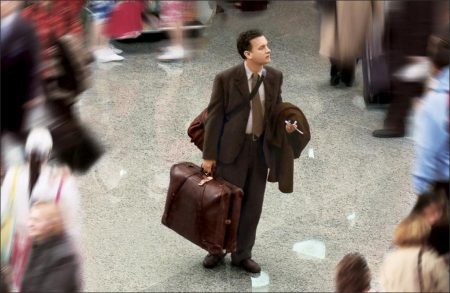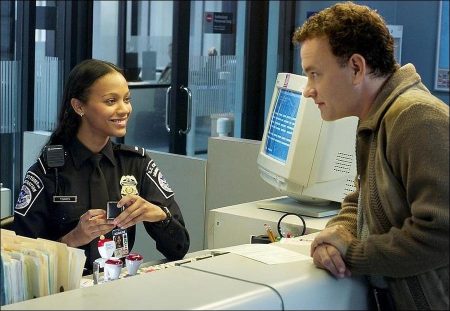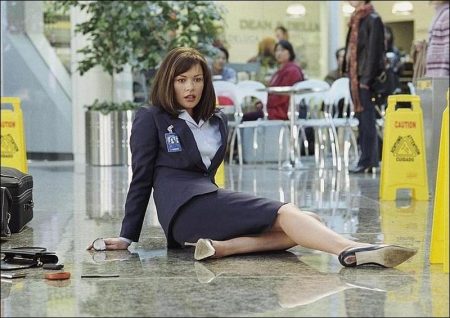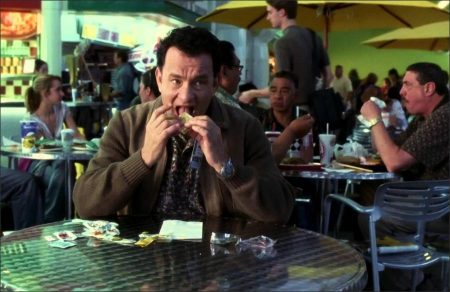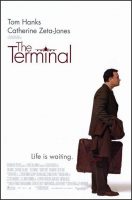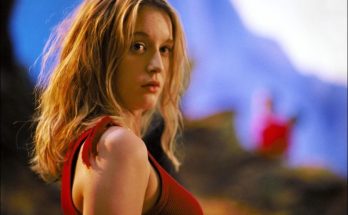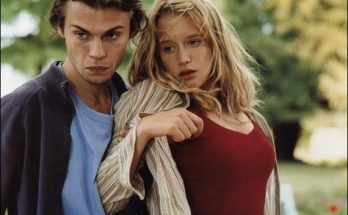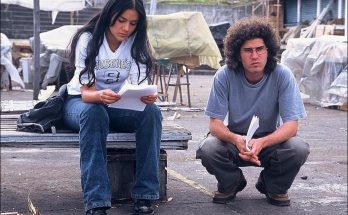The Terminal Movie Trailer. Former Krakozhian Viktor Navorski is almost in New York City for the first time in his life. “Former” and “almost”?: while Viktor is flying to JFK Airport, Krakozhia has been overthrown as a country with no nation recognizing the new regime, therefore all government papers such as passports, visas and currency issued by Krakozhia are also not recognized internationally. With only these papers in hand when Viktor arrives at JFK, he is not allowed entry into the United States.
All air service in and out of Krakozhia has been suspended and thus Viktor cannot even be sent back until Krakozhia’s situation is resolved. Frank Dixon, Director of Customs and Border Protection at JFK, allows Viktor to stay in the international lounge until the problem is resolved. Dixon gives Viktor enough meal vouchers to last for a day or two, with Dixon expecting Viktor to secretly escape the lounge into the outside world. Viktor, however, wants to be as proper as possible and decides to stay in the lounge. Viktor poses a problem for Dixon, as Viktor may be the black mark in his promotion to head of the department. Their relationship becomes an antagonistic one, where Dixon will now do whatever he can to prevent Viktor from ever entering the country even if he ever did learn the heartbreaking reason for Viktor’s visit.
As Viktor stays in the lounge, he only has limited resources on which to live and a limited understanding of the English language. Viktor’s encounters with lounge employees is also initially antagonistic, but they all learn to live in harmony and friendship as Viktor’s stay increases. The one person Viktor would like to meet and know is United Airlines flight attendant Amelia Warren, who is in transit through JFK every few weeks and who seems to be dealing with her own personal demons.
Now Boarding
If you travel by air, even occasionally, chances are you have been stuck in an airport terminal at one time or another. “Almost everybody has been stuck in an airport,” director/producer Steven Spielberg attests. “I don’t know anyone who hasn’t spent longer sitting in an airport chair than on the airplane ride itself at some point. Airports have become small microcosms of society.
There are places to eat, places to shop, places to meet people…” Producer Walter F. Parkes remarks, “If you are going to be stuck somewhere, an airport can actually be a fascinating place to be. They are places of high emotion-people are either saying goodbye or saying hello. There are intense reunions or the anticipation of absence. You get to see a cross-section of humanity parading through, and if you look at it that way, it’s not the worst place to spend a few hours.”
That being said, most people still view getting delayed at the airport for a few hours as an inconvenience. But try to imagine those hours stretching into days… weeks… and even months. That incredible circumstance is the premise of “The Terminal.”
Executive producer Andrew Niccol had the initial concept of a man who was detained at the airport and ended up living in the terminal. He developed the story with screenwriter Sacha Gervasi, who recalls, “I thought it was a brilliant place to start in creating a scenario that most people would never believe could actually happen.”
That idea grew into the screenplay “The Terminal,” which told the story of Viktor Navorski, an entirely fictional character from the equally fictitious Eastern European country of Krakozhia, who is en route to New York City when his country is torn apart by war. Viktor lands in New York only to discover that his identity has become a casualty of the war at home, and to be told that “America is closed”… at least to him.
Parkes says, “This is one of those stories that is really about the smallest moments of human interaction, and Sacha’s script kept the story very intimate. It’s about a man encountering a handful of people in a very closed environment, and yet there’s this impression that, in a way, he’s meeting what America is in this place. I think that makes the story truly interesting.”
Gervasi comments, “It seemed to be both incredibly profound and ironic that a man who may never be able to walk onto American soil would still be able to experience what life in America is like…to live the American dream in the terminal.”
Tom Hanks, who portrays Viktor Navorski, agrees.“Viktor experiences an immersion in the American culture by way of the condensed world of the terminal. There is a great cross-section of Americans at work in the airport and a huge amount of the American culture constantly on display there. Racial diversity and racial divisions can be readily sampled at the airport. What Viktor goes through is a crash course in the American melting pot.”
The script eventually made its way to Steven Spielberg, who read it as one of several screenplays the studio was considering. “It was the last script I read, and it made me forget the five scripts I’d read before it. I thought it was an amazing idea,” he remembers.
Jeff Nathanson, who had collaborated with Spielberg on “Catch Me If You Can,” later came on board to work on the screenplay. “I was attracted to the project because this is a fascinating time in our history, obviously,” says Nathanson. “This story allows us, in a very entertaining way, to explore some issues that I think are paramount to everything that’s going on in our country right now, so when I got the script, I was really excited.”
It wasn’t until Spielberg read the new draft of the screenplay that he made the decision to direct the film. “I had an immediate affinity for Viktor’s story. I believe all of us have felt a little bit like Viktor at some time in our lives-this displaced person in search of a life.”
“I think Steven was very interested in and challenged by the human comedy of this story,” Parkes notes. “It’s something he hasn’t done too much of, but is very good at. Not unlike `Catch Me If You Can,’ it’s the kind of movie that allows him to stretch his comedic muscles.”
“After `Catch Me If You Can,’ I wanted to do another movie that could make you laugh and cry and feel good about the world,” Spielberg acknowledges. “I wanted to do something else that could make us smile. This is a time when we need to smile more, and Hollywood movies are supposed to do that for people in difficult times.”
The Passengers
Even before Spielberg decided to occupy the director’s chair, Tom Hanks had signed on to portray Viktor Navorski, the man without a country who must make a home for himself in “The Terminal.”
“I read the screenplay and thought it was almost too good to be true,” Hanks states, adding that anyone who has touched down in a foreign country might relate in some way to Viktor’s plight. “I don’t think any human being who has been to a land where they don’t speak the language-or even if they do-has not felt that complete disenfranchisement. I remember the first time I went overseas, I felt incredibly, immediately self-conscious. I was nervous about approaching anybody…never mind having problems with your papers and with immigration and the Homeland Security Department and whatnot. So, yes, I think his situation is very relatable.”
Hanks goes on to say how Viktor’s predicament is not so far outside the realm of possibility, given the current security climate at our airports. “You can understand particularly how it could happen now: Somebody comes in from a different country where something terrible has happened and so, for all intents and purposes, his country doesn’t exist. His papers are no good and the Homeland Security Department isn’t about to say, `Well, enjoy your stay in New York City.’ The airport is supposed to be the doorway to the world where people are checked in, but in this case Viktor is checked, and he’s no good. He can’t come in and he can’t go home because those borders are sealed.
“What I liked about the screenplay is that Viktor comes to understand what’s at stake,” Hanks continues. “He understands the way the world works in this case. There is no point in him railing against the state, because it’s too big for him to conquer by himself, so while he’s here, he will make the best life that he can for himself.”
Jeff Nathanson adds, “Viktor’s life in his little village in Krakozhia could never have prepared him for something like this. He starts out as someone who desperately wants to get to New York City, but who will not cheat or break the law to do it. He wants to leave the airport when he’s allowed to go, and he will wait until he’s allowed to go.”
In the meantime, Viktor not only builds a life but a home in the terminal, complete with friends, employment and even a little romance. “Even though Viktor’s physical world is in limbo, his emotional world is not,” Hanks notes. “He keeps moving forward. He’s not sitting there like a lump, saying `Oh poor me.’ He actually goes on something of an emotional journey in order to experience all that America has to offer.”
Parkes observes, “If you look at the body of Tom’s work, there is a little thread of characters dealing with isolation, whether an intellectual one like Forrest Gump, or a physical one like a castaway on an island. I think the idea of Viktor as a man stranded in America-a stranger in a strange land-appealed to him on that level.”
Interestingly, although Hanks’ character was confined, Spielberg says that he turned in one of the more improvisational and physical performances of his career. “Of all the movies we’ve done together, this was the most inventive I’ve ever seen Tom be on the set. He really brought things to the character that weren’t in the script or in my imagination, things no one was expecting. After those scenes in which he’d do something extraordinary, I would ask him, `When did you come up with that?,’ and he’d say `About 10 minutes before you said `action.’ He was just vamping so many amazing moments…not just moments, but whole ideas about his character. He was also very physical with his body. He slips, he falls, he spins around, he can’t get comfortable in a chair… But it wasn’t Tom Hanks; it was how he saw Viktor Navorski, and what he brought to the character.”
Nevertheless, Spielberg is quick to point out, “Viktor is not a buffoon. In fact, he’s a very dignified person who is extremely trusting of others and always full of hope. He finds the bright side to every problem, and he has the patience of Job. Most of all, he has an insatiable curiosity about the human race.”
Viktor’s interest in people and open heart soon brings him friends, and even the possibility of a romance when a United Airlines flight attendant named Amelia Warren literally slips into his life. Catherine Zeta-Jones plays Amelia, whom the director describes as “a girl who is very unlucky in love,” adding, “It was Catherine’s challenge to convey all of Amelia’s vulnerability and insecurity, and I think she did an exceptional job.”
Zeta-Jones offers, “I think Amelia’s vulnerability is what attracted me to the part. I love the trust she puts in people; even when she gets hurt, she has a tiny iota of faith that it’s going to work out. She is also very open-she wears her emotions on her sleeve-so when she meets Viktor, she has no trouble expressing what’s going on in her life. She wants terribly to have someone who will just listen to her, and she finds that person in Viktor. It’s a wonderful coming together of two lonely characters that turns into a charming relationship.”
“Amelia had never experienced kismet,” Spielberg says. “If Cupid had fired his arrow into her, it struck her intellect more than her heart because she thinks she is in love with Max, played by Michael Nouri, who continually makes promises to Amelia that he never keeps. Viktor comes into her life as a confidant-not as a lover or as her knight in shining armor, but he listens, and that’s the beginning of a beautiful friendship.”
Hanks remarks, “It puts Viktor in the position of thinking that getting stuck in an airport may be one of the best things that’s ever happened to him because he got to meet this woman. But it’s not a mad crush. I think it’s based on the recognition of a kindred spirit who could use some help, and even though they don’t speak the same language, they have so much else in common. It’s a very adult relationship, which provided Catherine and me with something that can be a rare opportunity for actors. And it was a wonderful opportunity for me to work with Catherine Zeta-Jones, who is as magnificent as it gets.
“I love the relationship Amelia forms with Viktor, and it was such a pleasure to work with Tom,” Zeta-Jones comments. “When you are on the set with him day to day, you see how refined his craft is. He really is an artist. There is something so subtle and minimalistic in what he does, but it’s so clear and emotional. Tom made all the elements of his character so real that there were times when I would forget I had a line because I was so intently watching him work,” she laughs.
Concentrating on the elements of her own character, Zeta-Jones says, “When I was thinking about how I was going play Amelia, I thought about how it must be to be constantly on the move, to have your address book alphabetized by city. Amelia is very much connected to her job description in a way. She’s going somewhere all the time and never has enough time to stop, take a breath and form the kind of relationship she so desperately wants and needs in her life.”
“It was just a beautiful characterization,” Spielberg states. “I am so proud of Catherine for the work she did on this movie.”
Spielberg can take more than a director’s pride in Zeta-Jones’ performance. It was he who first spotted the actress in a miniseries, which led to her being cast in “The Mask of Zorro,” marking her first starring role in a feature film.
“It does feel full circle to me,” Zeta-Jones says, “even though Steven was a producer on `Zorro,’ and I never actually got to work with him. It was just a dream to be directed by him at last, and I was honored to be asked to participate in this particular project. When I read the script, I just fell in love with it, and doing the movie was a terrific experience.”
Stanley Tucci, who plays Frank Dixon, the airport official who is tightly wound in red tape, reveals he was also drawn to the project by the opportunity to work with Spielberg, as well as the script. “I had always wanted to work with Steven, and working with Tom for the second time after `Road to Perdition’ was very exciting. Also the character of Dixon was very well written; it’s a really wonderful role. He’s a complex character, which always appeals to me.”
“Stanley Tucci was my first choice to play the part of Dixon,” Spielberg states. “I never imagined anyone else. Then he came to the set and just overwhelmed me with how naturally he played the role. It was amazing how he fit Dixon’s shoes, and yet Stanley as a person is nothing like the character of Dixon. It was really a stretch for him to play this guy, but he did it wonderfully.”
Dixon, who runs the airport, starts out between a rock and a hard place. Rules and regulations prohibit him from letting Viktor leave the airport, but when Viktor’s constant presence threatens to jeopardize Dixon’s career, he’ll do just about anything to get Viktor out of the terminal.
Spielberg comments, “Dixon is not a villain. He is just doing his job, but he does it so well, he convinces us that he is the villain. Dixon has a lot at stake, especially now when he’s being considered for a job he’s always wanted. He knows inspectors are going to be observing how he functions on the job, and all of a sudden there’s this guy in a bathrobe walking around the food court.”
“He’s more of a formidable obstacle to Viktor than a villain, though he’s not always a nice guy,” Tucci admits. “At first, Dixon really wants to help the guy, but their relationship become adversarial. The situation just gets worse and worse and is only exacerbated by all the red tape.”
“I think Dixon is a victim of what’s wrong with bureaucracy when the human element is ignored,” notes Spielberg.
Tucci adds, “It’s a little glimpse into the downfalls of bureaucracy in our society. I think it’s interesting that this person who only wants to get to America to achieve a very simple goal is ultimately thwarted by all things American.”
“`The Terminal’ is really an immigrant’s tale,” Spielberg offers, although Viktor Navorski is not technically an immigrant, as he only plans to visit New York City. “It goes back to what makes this country so great and so strong-immigrants coming here from around the globe to `the land of milk and honey,’ a place where they are allowed to dream of a better life for themselves. In some ways, we have lost sight of the immigrant’s plight because security is more intense than ever before, and justifiably so. I think in a sense, this story celebrates the great American melting pot. That is why Viktor interacts so effortlessly with people from different cultures and walks of life so effortlessly, and why I wanted to have such an international cast.”
Producer Laurie MacDonald attests, “From the earliest development stage, we always discussed how the world at the airport should reflect all of America with a multi-cultural cast of characters. There’s also an element of `Upstairs, Downstairs’ within the group,” she says, referring to the hierarchy that exists among the airport employees.
Parkes agrees, “In many ways, the world Viktor encounters at the airport is like America in microcosm, with all of its depth and richness of character. And he meets this group, which comes to represent for him-and hopefully the audience-the best and worst that the country has to offer.”
At the center of Viktor’s extended airport family are: Chi McBride as Joe Mulroy, the baggage handler who seems to be the natural born leader of the group; Diego Luna as Enrique Cruz, the food service worker who uses his job to strike a mutually beneficial deal with Viktor; Kumar Pallana as Gupta, the janitor whose cart is his private domain and who has a unique way of exercising his power; and Barry Shabaka Henley and Zoë Saldana respectively as U.S. Customs and Immigration Officers Ray Thurman and Dolores Torres, who can’t help but sympathize with Viktor’s situation, although they are powerless to change it.
Barry Shabaka Henley notes, “Ray Thurman makes the choice to adhere to what he considers the higher calling of duty. Duty is what drives him, but it causes a conflict in his heart, which goes out to this person he really can’t help. Ray has to adopt a posture of neutrality because he could easily get drawn in if he allowed himself to. He knows that sometimes you have to distance yourself from the way you feel to do the job you have to do.”
Chi McBride, who plays Joe Mulroy, remarks, “Viktor is the kind of guy who’s hard to be around and not be affected by his goodness. My character, Joe, is a guy who has spent the better part of his life slinging bags at the airport. He’s a bit of a grouch and very matter-of-fact about his job. He just wants to finish his shift and go home where he doesn’t pick up anything that weighs more than a 12-ounce can. The last thing he wants is to be burdened by somebody else’s problems, but when you’re around a guy like Viktor long enough, you just wanna make sure he’s okay.”
“I guess every character ends up in a completely different place from where they started, which has a lot to do with Viktor Navorski,” says Zoë Saldana, who plays Dolores Torres. “Every character in the film has been affected one way or another by this man who is completely trapped in a seemingly hopeless situation, and yet somehow still has the power to bring hope to everybody in their own circumstances.”
It is Dolores who has arguably the most life-altering interactions with Viktor Navorski, having to do with her love life. Officer Dolores Torres sits at a counter with two stamps-Approved and Denied-which spell the difference between entering the United States or being detained at the airport. Every day Viktor fills out the proper forms and waits in line, hoping that he will one day see her pick up the stamp marked APPROVED.
It is in Viktor’s daily encounters with Officer Torres that food service worker Enrique Cruz sees an opportunity to finally make a connection to Dolores, whom he has loved from afar. He enlists Viktor as an undercover matchmaker in exchange for daily selections from the First Class menu. Diego Luna, who plays Enrique, explains, “My character notices that Viktor makes Dolores laugh, so he sees it as a chance to get close to the woman he loves. He feeds Viktor in exchange for information about Dolores that will help Enrique win her heart.”
There is one member of the group whose trust Viktor has a harder time earning: the janitor Gupta, who has his own questions about this stranger who suddenly turns up living in the terminal. “Gupta is suspicious of him,” expounds Kumar Pallana, the actor who plays Gupta. “He doesn’t know if he’s CIA sent to spy on us or what. It’s a question of trust.”
“Kumar had the part the minute he walked in the door,” Spielberg says of the 85-year-old actor.
Born in India, Pallana has had a long and storied career, which included stints as a juggler and plate spinner. Decades later, Pallana proved that he hasn’t lost a step in a scene where Gupta provides some unique dinner entertainment for Viktor and Amelia.
Tom Hanks’ character added to the international flavor of the cast even though his country of origin, Krakozhia, never existed on any real map. Hanks notes, “Krakozhia is presumably one of those republics that used to be part of the Soviet Union. There is a common pool of the Cyrillic languages, so we began with that and went from there. It’s not just the matter of the accent; there are other rules of speaking that differ from ours. For example, when we ask questions, the emphasis goes up at the end of the sentence, whereas theirs goes down. There’s literally another kind of logic to their language, so it ends up being behavioral as opposed to just talking `funny.’”
The Ground Crew
Given the title of the movie, the centerpiece of the production was the terminal itself. The filmmakers recognized early on that it would be impossible to shoot the movie in a real airport, given the security constraints. Instead, production designer Alex McDowell was charged with designing and constructing a completely operational, full-sized airport terminal in which almost all of the filming would be accomplished. At the tail end of principal photography, some interior and exterior scenes were filmed at Montreal’s Mirabel Airport, where United Airlines lent the production a Boeing 747 for one pivotal scene.
Spielberg, who had collaborated with McDowell on “Minority Report,” notes, “The only marching order I gave Alex was to say, `Look, the star of this movie is Viktor Navorski. It’s a character piece, but the name of the movie is `The Terminal,’ so the setting the character is in has to look like a modern international terminal.’”
McDowell designed the terminal set, first in the computer and then as a scale model, which allowed Spielberg to pre-plan his shots using a little periscope camera that enabled him to “walk” visually through the airport set.
During the design phase, Spielberg’s longtime cinematographer Janusz Kaminski collaborated with McDowell on designing what would become a state-of-the-art lighting system into the plans. McDowell affirms, “As much as anything, the stage is a giant light box, so it was extremely important to build the lighting design into the set from the very beginning. This wasn’t a case of the set being built and the director of photograpy coming in and saying, `I want light here, here and here.’ Janusz was involved in integrating the lighting into the set design from its inception.”
While the terminal in which Viktor is detained is presumably at New York’s JFK International Airport, McDowell wanted it to be more of an amalgam of several international terminals in order to give it a feeling of familiarity to almost any frequent or not-so-frequent flyer. He and his design team researched airports from coast to coast in the United States, as well as in a number of European capitals.
The terminal set was built from the ground up in a massive hanger located in Palmdale, California’s aerospace alley. Construction took approximately 20 weeks and involved more than 200 artisans and workers. Unlike a typical soundstage set, the terminal was built as a freestanding piece of real architecture, a literal three-stories-high atrium-style building within a building.
The self-supporting structure was made of steel throughout, with glass windows and 60,000 square feet of genuine granite flooring. An entire infrastructure of electrical wiring and fiber optic cables, needed to power the set and the flight information displays, was buried beneath the flooring and ran the length and breadth of the set. Among the many notable features of the terminal set were four working escalators, which were among the first actual escalators ever built specifically for a movie set.
The reality of the terminal brought another team into the mix. McDowell explains, “Normally, when you’re designing a temporary set, you don’t have to concern yourself too much with engineering. In this case, every single welded joint had to be inspected. Every drawing that came out of the art department had to be vetted by a team of engineers, so that was a different experience for all of us.”
The design did not end at the terminal’s periphery of large glass picture windows. The windows overlook an airfield, which was depicted on one of the largest matte paintings ever created. The gigantic backdrop, which wrapped around three sides of the set, was fixed with 2,000 miniature lights that were illuminated for night scenes. A blue screen was only utilized when the filmmakers wanted to show an actual plane pulling up to the terminal.
Among the more remarkable aspects of the set were the dozens of restaurant and retail outlets situated in the terminal. Executive producer Patricia Whitcher was responsible for getting all the retailers to come on board, which resulted in more than 35 companies being represented in the retail mall and food court, ranging from fast food to high fashion.
“Having 35 stores is like having 35 individual sets,” McDowell points out. “Each one had its own lighting requirements and specific properties based on the actual stores, so it was a very complicated process.”
In addition to the requisite Duty Free Store and CitiGroup ATMs, the retail outlets include: Verizon Wireless, Dean & Deluca, Discovery Store, Brookstone, Cambridge SoundWorks, Hugo Boss, La Perla, American Express, Hudson News, Borders Books, Paul Mitchell, Godiva, Swatch, Harry and David’s, Origins and Smarte Carte.
In and around the terminal’s food court, you could treat yourself to Burger King, Auntie Anne’s Pretzels, Baskin-Robbins Ice Cream, Baja Fresh, Panda Express, Nathan’s Famous, Au Bon Pain, Yoshinoya, S’Barro, Krispy Kreme, The Daily Grill and, of course, the ubiquitous Starbucks.
Some of the food outlets, including Starbucks, Auntie Anne’s and Baja Fresh, were staffed by actual employees. In other instances where extras minded the stores, they were given employee training sessions just as if they were going to work behind the counter.
Adding to the verisimilitude of the fabricated terminal, the main flight information board and all monitors displayed actual flight schedules from the International Terminal at JFK International Airport. Solari Di Udine shipped and installed the large flight information board with its split-flap technology. In addition, the terminal featured the newly adopted color-coded, traveler-friendly signage, called the Wayfinding System. Designed by the award-winning Dutch design firm Bureau Mijksenaar, the system, which is the way of the future, was only very recently introduced at JFK and a handful of other major international airports.
When the terminal set was completed, it had the desired effect on the entire cast and crew. Catherine Zeta-Jones recalls, “When I first walked on the set, which you had to see to believe, I turned to Steven and said, `I’m breathless.’ It literally took my breath away. It had that real feel to it. It even smelled like an airport.”
“The set was magical,” Tom Hanks affirms. “The first time I saw it, it was six times larger than I expected it to be. It was hard to comprehend how they had gotten it all done.”
Even Spielberg was blown away by its scope. Whitcher reveals, “When Steven walked on the set for the first time, he said, `I love it. It’s remarkable. You’ve brought me cinema,’ which was incredibly rewarding to everyone.”
The lighting of the enormous set was a challenge unto itself. Spielberg notes, “I told Janusz that I wanted to make it as if we were on location filming in a real terminal, and that is exactly how Janusz made everything look.”
It sounds a great deal simpler than it was. To create lighting that mimicked sunlight streaming in from the windows, a track of 100,000-watt lights was placed along the length of the set’s steel truss ceiling. The lights were pointed upwards and outwards into a huge canopy of white Ultrabounce fabric that wrapped the set like a cocoon. As its name suggests, the light bounced off of the fabric and diffused to create a sunlit ambience.
Kaminski also utilized color changes in the lighting to subtly convey the evolution of Viktor’s circumstances. Spielberg expounds, “In the film’s earlier scenes, Janusz used cool tones of blue and green because at that point, you don’t think of the airport and immigration as a very warm place to be. The cool tones are evident until Viktor starts to settle into his predicament and he realizes he’s going to be stuck in this airport for an unspecified amount of time. Then, as you get to know Viktor and he becomes more at home, the colors in the movie start to move towards the warmer tones.”
Viktor’s gradual acclimation to his temporary home is also reflected in his wardrobe. Costume designer Mary Zophres surmised that someone like Viktor would wear a suit for his first visit to the United States. However, Viktor comes from what they presumed was a small village in Krakozhia, “where they don’t get their suits made to measure,” Zophres asserts. “To me, it had to look like a mass-produced suit that he’s probably owned for at least five years and doesn’t fit him quite right. It’s very boxy, made from a thick-textured, old-world fabric, and I also stripped it of any details like a chest pocket or pocket flaps.”
That first suit is a stark contrast to the tailored Hugo Boss suit in which we later see Viktor. But in between, there is a gradual transformation in his overall wardrobe that conveys not only the passage of time, but also Viktor’s growing ease with his living situation. “He goes from somebody who has just arrived in America to looking relatively American,” Zophres states.
Zophres, who designed the colorful stewardess uniforms for the `60s-era “Catch Me If You Can,” stayed more on the conservative side for the 21st-century United Airlines flight attendant’s uniform worn by Catherine Zeta-Jones as Amelia. Taking a few liberties with the actual uniform worn by the airline’s flight attendants, Zophres says, “we replicated the uniform as closely as we could, but tailored it to fit Catherine better. We wanted her to look like she’s wearing a uniform, but we also wanted it to be flattering.”
For the other uniforms seen in the terminal, Patricia Whitcher and the costume department worked closely with the Department of Homeland Security to obtain the proper insignia and uniform styles.
Zophres had a lot more creative freedom with the ethnically diverse costumes worn by the thousands of extras who passed through the terminal on their way to or from the four corners of the globe. Zophres spent weeks shopping in every ethnic pocket in and around Los Angeles to find clothing that was rich in both color and cultural traditions for the milieu of the airport.
“Mary had the best time with the extras’ wardrobe,” Spielberg comments. “She was very daring in how she dressed some of them because, let’s face it, you never know what you’re going to see walking through an airport.”
Composer John Williams also brought an ethnic quality to the musical score of “The Terminal.” He notes, “I wanted to create a musical portrait for Viktor that has an ethnic feel. We know Krakozhia is located in Eastern Europe, so I featured a clarinet in his themes, which is in the idiom of so much of Eastern European music. I also included a cimbalom, which is indigenous to Hungary, and the subtle use of an accordion, which were woven into the orchestral texture to suggest Viktor’s origins and culture.”
Spielberg, whose association with Williams dates back to the director’s first movie, “The Sugarland Express,” adds, “The music captures the Eastern European flavor of Viktor’s character, but never neglects the richly American sounds of Amelia’s story. Then John wrote another beautiful theme that brings the two characters together.”
“The Terminal” marks Spielberg’s eighteenth feature film collaboration with editor Michael Kahn, although Spielberg says, “Michael and I don’t think of ourselves as collaborators. It’s more like an extraordinary brotherhood. We read each other’s minds; we make the same choices at the same time. We really share the same brain in the editing room.”
Spielberg and Kahn worked together to create a fast-paced story, which might seem like a contradiction to the film’s tag line: “Life is Waiting.” The director counters, “Even though Viktor is stuck in the terminal, everything happening around him is a blur. So there is a tremendous volume of travelers moving to and fro while Viktor, by contrast, is the only one standing still. There is one shot where Viktor is just standing there, and as the camera pulls back, he becomes invisible. You lose him in this sea of people moving in every direction of the compass-everyone except him. So there is an energy to the story. Waiting can be exciting. Waiting can be entertaining.”
The Terminal (2004)
Directed by: Steven Spielberg
Starring: Tom Hanks, Catherine Zeta-Jones, Chi McBride, Stanley Tucci, Diego Luna, Kumar Pallana, Zoe Saldana, Eddie Jones, Jude Ciccolella, Corey Reynolds, Guillermo Díaz
Screenplay by: Sacha Gervasi, Jeff Nathanson
Production Design by: Alex McDowell
Cinematography by: Janusz Kaminski
Film Editing by: Michael Kahn
Costume Design by: Mary Zophres
Set Decoration by: Anne Kuljian
Art Direction by: Christopher Burian-Mohr, Brad Ricker
Music by: John Williams
MPAA Rating: PG-13 for brief language and drug references.
Distributed by: DreamWorks Pictures
Release Date: June 18, 2004
Views: 233
